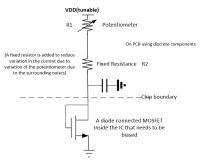venn_ng
Member level 5
Hi,
I am trying to give the DC bias current to an IC from an external source. The way I am generating this current is by using a potentiometer structure shown below.

By changing both VDD (tunable) and R1 (potentiometer), I can change the current. The VDD comes from an LDO and hence it's kind of accurate.
The thing is I placed another series resistor R2 to reduce the variations in the current due to possible variations in the potentiometer, as I heard potentiometers are very sensitive to their environments and tend to change with time a lot.
My quesiton is if I keep R2 like 25% of R1, would it be good enough? Also, is this a good way of generating current externally for biasing circuits inside an IC?
Thanks in advance
I am trying to give the DC bias current to an IC from an external source. The way I am generating this current is by using a potentiometer structure shown below.

By changing both VDD (tunable) and R1 (potentiometer), I can change the current. The VDD comes from an LDO and hence it's kind of accurate.
The thing is I placed another series resistor R2 to reduce the variations in the current due to possible variations in the potentiometer, as I heard potentiometers are very sensitive to their environments and tend to change with time a lot.
My quesiton is if I keep R2 like 25% of R1, would it be good enough? Also, is this a good way of generating current externally for biasing circuits inside an IC?
Thanks in advance